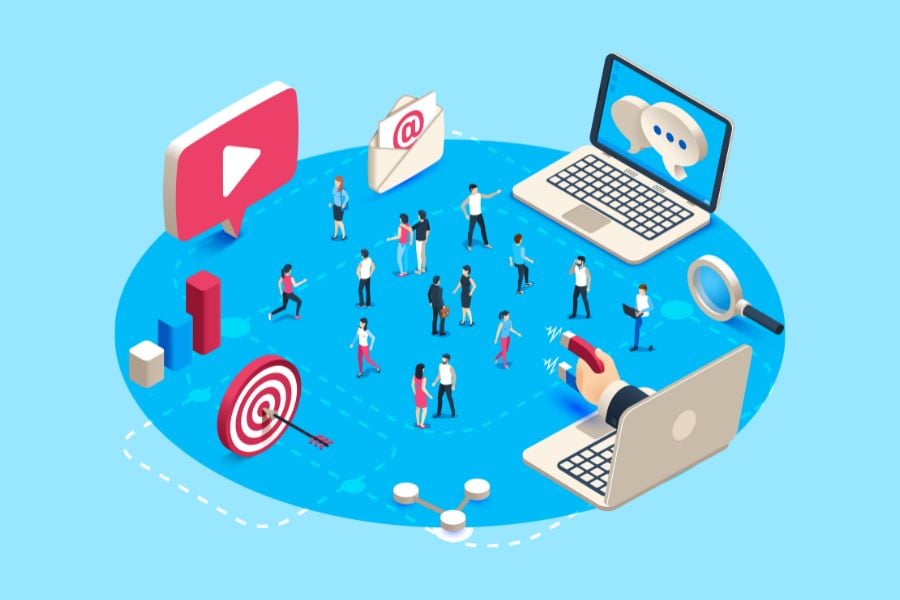Ever wondered how some businesses manage to attract a loyal following, while others struggle?
They’re likely masters of inbound marketing, an approach that’s about drawing customers in, rather than bombarding them with sales pitches.
If you’ve ever found a helpful blog post while searching for a solution to your problem, you’ve seen inbound marketing in action.
And if you want to learn more about how inbound marketing works (and how to make it work for you), this guide will show you how to harness the power of inbound marketing to turn strangers into loyal customers.
So, ready to unlock the full potential of your business?
Let’s dive right in!

What is Inbound Marketing?
Let’s get straight to it: what is inbound marketing?
Well, think of it as a magnet, drawing customers in rather than chasing them down.
Instead of traditional marketing methods such as cold calling, direct mail, or television ads, inbound marketing focuses on creating educational content that pulls people towards your business and product where they naturally want to be.
Now, compare this to outbound marketing, often seen as the pushy cousin.
Outbound methods are typically interruptive and invasive, like those annoying pop-up ads that ruin your online browsing experience.
Inbound marketing, on the other hand, is about attraction. It’s about being the helpful voice when a customer asks, “How do I solve this problem?” It’s about creating content so engaging that it pulls people to your business.
And why should you care about inbound marketing?
Well, in this information-saturated era, consumers have learned to tune out the noise.
They don’t want to be sold to; they want to educate themselves and make their own decisions.
Inbound marketing positions your business as a helpful guide in that decision-making process, building trust and credibility.
The 4 Stages of the Inbound Marketing Methodology

The heart of inbound marketing consists of four basic stages, each one leading your customer ever closer to buying from you. Here are the four stages:
Stage 1: Attract
Think of the attract stage as setting up a magnetic field around your brand. This isn’t about attracting just anyone but your ideal customers — the ones who resonate with your brand ethos, and have a genuine need for your product or service.
So, how do you do that?
The key is producing content that appeals directly to these folks. Whether it’s an enlightening blog post, a crisp infographic, or an engaging video, your content needs to speak their language.
And by using relevant SEO strategies like keywords, meta descriptions, and links, you increase the odds of your ideal customers stumbling upon your content online.
Stage 2: Engage
Once you’ve caught your prospective customers’ attention, the next stage is about winning their hearts and minds.
Remember, getting attention is only half the battle; you’ve got to hold onto it too.
Engagement involves fostering a two-way conversation. This is done by personalizing your content, making it interactive, and keeping it relevant.
Think tailored email campaigns, social media interactions, or user-friendly webinars.
The aim is to build a genuine connection, making it clear that you’re not just out to make a quick buck, but you’re there to solve their problems and meet their needs.
Stage 3: Delight
When it comes to the delight stage, your goal is to put a smile on your customers’ faces and keep it there.
Now, this isn’t about one-off gestures, but providing a consistently great experience.
This could mean going above and beyond with your customer service, or continuously offering content that adds value even long after a purchase has been made.
The idea is to make customers so happy they can’t help but come back and buy more, and also spread the word about your brand to their friends and loved ones.
This turns them into brand ambassadors who amplify your message and help you attract even more ideal customers.
Stage 4: Transform
Now, we’re onto the final stage – transform.
This is where those happy customers become true brand believers. These folks don’t just like your product; they can’t imagine their lives without it.
But how do you take customers on this transformative journey?
You nurture the relationship beyond the point of sale. This could be with a loyalty program that rewards them for sticking around, special events that make them feel part of your brand family, or exclusive content that continues to deliver value.
It’s all about making them feel special and showing them how much you appreciate their loyalty.
10 Top Inbound Marketing Tactics That’ll Enhance Your Campaigns (& Win Customers)

So, how can you use the principles of inbound marketing to create a successful inbound marketing campaign?
Here are some powerful strategies to do just that:
1. Create a Buyer Persona
One of the pillars of a successful inbound marketing strategy is knowing your audience inside out.
We’re talking about creating detailed buyer personas.
These are semi-fictional representations of your ideal customers based on market research and real data about your existing customers.
By understanding their needs, challenges, and motivations, you can tailor your content and messaging to hit the right chords.
2. Content Creation
Content is the fuel that drives inbound marketing. Blogs, whitepapers, infographics, podcasts, videos — you name it, they’re all different types of content that can be used to attract, engage, and delight your target audience.
However, it’s crucial to create content that is not only high-quality and informative but also shows your brand personality.
It’s your chance to let your expertise shine and build trust with your audience.
3. SEO Strategy
Visibility is vital in the noisy digital landscape. That’s where a solid SEO strategy comes into play.
By optimizing your content and website for search engines, you increase the chances of your ideal customers finding you when they’re looking for answers.
But remember, SEO isn’t just about keywords.
It’s also about providing a smooth user experience. Fast loading times, mobile-friendly design, and easy navigation are all essential for keeping visitors (and search engines) happy.
Learning how to do SEO properly is an entire course in itself, but master this skill and the online world will be your oyster.
3. Social Media Engagement
When it comes to inbound marketing, social media is a powerhouse. It’s not just about broadcasting your messages; it’s about starting conversations, engaging with your audience, and building a community.
So, use your social channels to share valuable content, solicit feedback, and interact with your followers.
4. Email Marketing
Despite the rise of social media, email marketing remains a powerful tool for inbound marketers.
It’s a fantastic way to keep your audience informed, share valuable content, and nurture leads.
With segmented lists and personalized messages, you can ensure your emails hit the mark every time.
5. Analytics

Finally, don’t forget to keep an eye on your progress.
Use analytics tools to track your success, understand what’s working, and identify areas for improvement.
Remember, inbound marketing isn’t a set-it-and-forget-it strategy; it requires constant monitoring and tweaking to get the best results.
6. User-Generated Content
Ever thought about letting your customers do some of the talking?
User-generated content is a goldmine that’s often overlooked. It’s authentic, relatable, and boy, does it resonate with audiences!
Think about it — who better to sell your products or services than happy customers themselves?
So encourage folks to share their experiences. Maybe it’s a photo contest on Instagram, testimonials on your website, or customer stories on your blog. Make your customers the heroes of your brand story.
It’s a win-win! Your customers get their moment in the spotlight, and you get credible and engaging content.
7. Collaborations

Imagine two superheroes teaming up to fight evil — pretty cool, right?
That’s kind of what brand collaborations are like in the world of inbound marketing.
By partnering with another company, you tap into a whole new audience, and they tap into yours.
The key here is to find a brand that complements yours.
For example, a software company could partner with a training provider for an informative webinar series. Or an organic food brand might team up with a fitness influencer for a healthy living campaign.
It’s about creating synergies that multiply your reach and offer new, exciting content to your audience.
8. Interactive Content
Ever heard of interactive content? It’s content that… well, gets your audience involved. And we’re not just talking about a call-to-action at the end of a blog post.
Think quizzes, surveys, calculators, interactive infographics — the possibilities are vast.
Here’s the cool part: interactive content is engaging, shareable, and, if done right, highly memorable. It provides a unique value to your audience by giving them personalized results or insights.
Plus, it encourages active participation, which can significantly boost engagement rates.
It’s a little out-of-the-box, but then, who said inbound marketing was about playing it safe?
9. Podcasts
Finally, let’s not forget about podcasts.
They’ve exploded in popularity, and for good reason. Podcasts offer a personal, engaging way for audiences to consume content.
They’re convenient (consumable on the go), intimate (it’s like having a one-on-one conversation), and often highly entertaining.
For brands, podcasts can be a unique way to showcase their personality, share stories, interview industry experts, and discuss topics that resonate with their audience.
They can help to build a loyal listenership that translates into a dedicated customer base. But remember, the key to a successful podcast lies in offering valuable content consistently and crafting a unique voice that listeners can connect with.
10. Influencer Marketing
Influencer marketing is all about partnering with influencers in your niche to tap into their large and loyal following.
The trick is to find influencers whose values align with your brand and who have a high level of trust with their audience.
The result?
You get access to a pool of potential customers who are already inclined to listen to what you have to say.
Remember, this strategy isn’t just for big brands. Micro-influencers, with smaller but highly engaged audiences, can be equally effective for small and medium-sized businesses.
Unlocking the Power of Inbound Marketing
As you can see, there are plenty of strategies you can use to bring potential customers to you.
The core of the concept is to let your customers know what you are all about and how you can add to their lives, so that they will be attracted to your brand like moths to a flame.
You’ve already taken a huge step by reading this guide. Now, it’s time to transform that newfound knowledge into action.
Picture a future filled with engaged, loyal buyers. You’ve got the strategies, the tactics, and the drive. All that’s left is for you to take that leap.
So go on — It’s time to bring in those loyal buyers and show them what you can do for them!
The post What is Inbound Marketing? 10 Tactics to Capture Loyal Buyers appeared first on Smart Blogger.

No comments:
Post a Comment